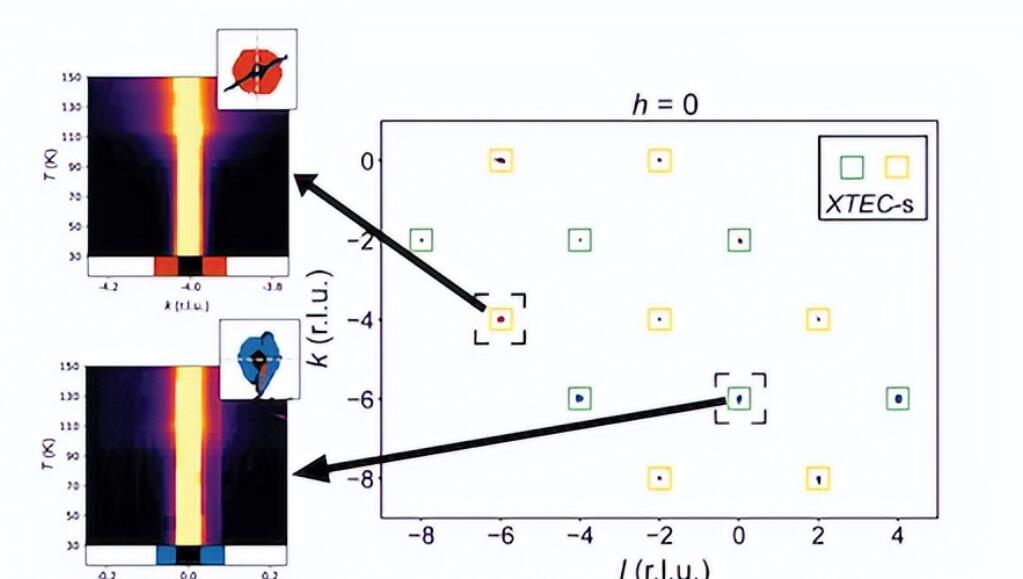The U.S. Department of Energy’s (DOE) Argonne National Laboratory, in collaboration with several universities, has devised a method for creating color-coded maps of massive amounts of data from X-ray analyses. The new tool, which uses computational data sorting to find clusters associated with physical properties, such as atomic distortions in crystal structures, will speed up future studies of temperature-induced changes in atomic-scale structure.
Machine learning methods that leverage massive amounts of X-ray data will speed up material discovery. Color coding makes aerial maps easier to understand, and with colors we can see at a glance where there are roads, forests, deserts, cities, rivers or lakes.
figure 1:Machine learning provides color-coded maps of X-ray data based on the temperature dependence of each region.
X-TEC identified the locations of two sets of spikes (yellow and green squares) in the data, as well as the diffuse halo around them (red and blue).
“Using machine learning to rapidly analyze large amounts of data from X-ray diffraction, which used to take months, now takes about 15 minutes,” said Raymond Osborn, a senior physicist in Argonne’s Materials Science Division. At the same time the results are more refined.”
Thanks to machine learning, we are able to see material behaviors that cannot be seen with conventional X-ray diffraction (XRD).
For over a century, X-ray diffraction has been one of the most fruitful of all scientific methods of analyzing materials. It provides critical information on the three-dimensional atomic structure of countless technologically important materials.
At large facilities, such as the Advanced Photon Source (APS) at Argonne’s DOE Science User Facility, the amount of data generated by XRD experiments has grown substantially in recent decades. However, analytical methods capable of handling these huge datasets are very lacking.
The team calls their new method “X-ray Temperature Clustering,” or XTEC for short. It accelerates material discovery by rapidly clustering and color-coding large X-ray datasets to reveal previously hidden structural changes that occur as temperatures increase or decrease.
A typical large dataset is 10,000 GB, which is equivalent to about 3 million music songs.
XTEC harnesses the power of unsupervised machine learning, using methods developed by Cornell University for the project. This type of machine learning does not depend on initial training and learning, while the data is already well studied.
Instead, learn without training by finding patterns and clusters in large datasets, and then color-coding to represent those patterns.
“For example, XTEC might assign red to data cluster one, which is associated with a particular property that varies with temperature in a particular way. Cluster two would be blue and have a different temperature than the other,” Osborne said. Attributes of dependencies are associated, and so on. The colors indicate whether each cluster represents a road, forest, or lake in an aerial map.”
As a test case, XTEC analyzed data from the APS beamline 6-ID-D, taken from two crystalline materials that superconduct at temperatures close to absolute zero.
At this ultra-low temperature, these materials transition into a superconducting state with no resistance to electrical current. More importantly for this study, other anomalous features associated with structural changes in materials also appear at higher temperatures.
By applying XTEC, the team gained unprecedented information about changes in atomic structure at different temperatures, including not only distortions in the orderly arrangement of atoms in the material, but also the fluctuations that occur when such changes occur.
“Thanks to machine learning, we were able to see material behavior that conventional XRD couldn’t,” Osborne said. “Our approach is applicable not only to many big data problems in superconductors, but also to batteries, solar cells and any temperature-sensitive device.”
APS is undergoing a massive upgrade to increase the brightness of its X-ray beam by a factor of 500. With the upgrade, the data collected by the APS will increase significantly, and machine learning techniques will be essential to analyze this data in a timely manner.
The study, published in the Proceedings of the National Academy of Sciences, is titled “Using Interpretable and Unsupervised Machine Learning to Process Big Data in Modern X-ray Diffraction.”
